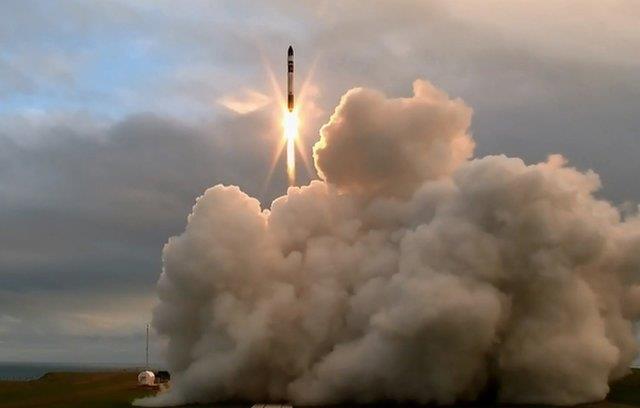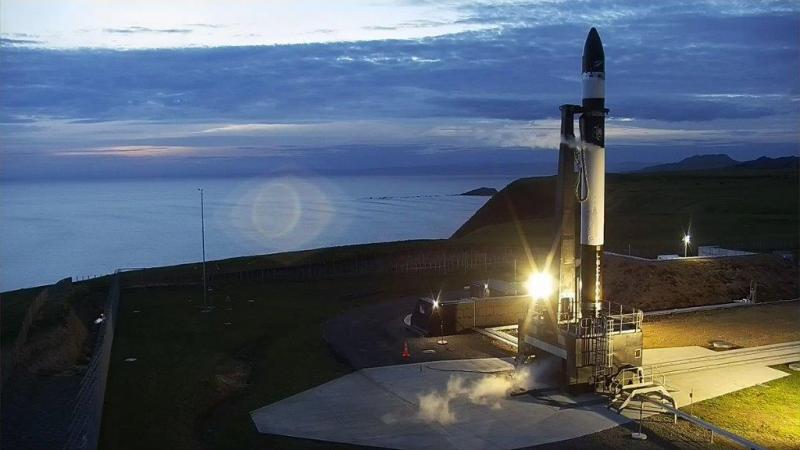Alaska Aeropspace Proposes Big Island Launch Site
The Alaska Aerospace Corporation (AAC) wants to build the Pacific Spaceport Complex-Hawai‘i (PSCH) in the Panaewa area of the Big Island from which to launch rockets. The corporation has launched 17 rockets over 15 years from 1998 to 2015, averaging about one launch a year.

Rocket Lab USA May 25, 2017 New Zealand Launch. AAC provided range safety and telemetry support. PC: Alaska Aerospace.
An environmental assessment (EA) is being drafted for the proposed launch facility on the Big Island. AAC operates the Pacific Spaceport Complex on Kodiak Island and wants to build its next site for launches closer to the equator as its program in Alaska is currently on hold.
A launch site design was submitted in June of 2018, for the EA.
“The development team has designed the site for two separate launch pads within the desired 15 acres for both liquid and solid propellants,” according to the June minutes. “AAC is currently awaiting permission from local government agencies to clear an access road to the site to conduct the environmental and archeological assessments. After that the environmental team will finalize their environmental assessment and move to public scoping.”

Rocket Lab USA May 25, 2017 New Zealand Launch. AAC provided range safety and telemetry support. PC: Alaska Aerospace Corporation.
In a response letter written on Nov. 27, 2018, to Mark D. Lester, president of PSCH, Hawai‘i County Mayor Harry Kim wrote:
I am writing in response to your Nov. 9, 2018, notice of pre-assessment consultation for the construction and operation of the proposed commercial spaceport, Pacific Spaceport Complex-Hawai‘i (PSCH). Thank you for the opportunity to comment. The county encourages the identification of opportunities to build upon a fully integrated economy that benefits a diversity of local businesses, residents and the environment. In doing this, a full and careful review of its impact to this community is required.
ARTICLE CONTINUES BELOW ADARTICLE CONTINUES BELOW ADA full discussion of the size, activities, specific type of payloads including any payloads that would serve as a red flag such as nuclear fuels, wastes or related component parts. Careful consideration and engagement should be targeted with the residents of East Hawai’i and in particular residents of the Panaewa Homesteads as to any potential impacts and planned mitigation actions. Discussion should include noise, lights, safe disposal of any by-products, handling and spills associated with rocket fuels and/or hazardous waste and accompanying robust mitigation strategies.
Please also address the various impacts of the trucks transporting construction components and launch supplies and materials including potential congestion, safety, and waste. Appropriate various alternative hauling routes and schedules should be considered.
Potential impacts on local businesses and government resources should be addressed including adjacent visitor destinations, agricultural and fisheries operations and valued astronomy facilities atop Mauna Kea. Impact and mitigation strategies may also include the growing amount of trash accumulating in space including that within Earth’s orbit.
As Hawai‘i Island has a high propensity for natural hazards including tsunami, volcanic activity, ground fracturing and subsidence, along with hurricanes and wildfires—these potential events should be noted and mitigation addressing detailed assessment of corporate, and government emergency response capabilities.
Again, thank you for the opportunity to comment. Please notify the county when the Draft Environmental Assessment is available for review.
This is not the first time a launch site has been considered for the Big Island.
In 2016 Rep. Derek Kawakami introduced a bill for a proposed launch site near the Mauna Loa Macadamia Nut far. That bill failed to pass.
Craig Campbell, CEO of AAC, has described the site being looked at in the Environmental Assessment as being east or northeast of the macadamia nut farm in Panaewa. He said the rockets would be 20 feet to 40 feet tall.
Campbell doesn’t believe that noise will be a problem and that the rockets wouldn’t be any louder than planes arriving or departing Hilo Airport or the cars racing at the Hilo dragstrip. Noise pollution will be addressed by the EA, which will be available at community meetings once they are scheduled.
Big Island residents have resisted for the most part any talks of these type of projects and the most recent one was proposed for possible spot near Pohue Bay in the Ka‘u District called SpinLaunch.
At an April 14, 2018, community meeting, residents spoke up about their concerns of SpinLaunch. SpinLaunch was considering four different states for potential launch sites within the United States.
VC: Big Island Video News
Sen. Russell Ruderman was asked about this proposed project and he stated:
“I know few details about it at this point. But generally, all previous proposals for a ‘spaceport’ and rocket-launch facilities have died of their own stupidity. This is not the place for such, because we have a delicate environment, and our state is already populated!
Once again, someone is asking Hawaii to embrace a technology that does not even exist! Someone wants us to be the suckers, er, I mean guinea pigs, for an unproven, unsafe project. Like each other proposed rocket launch facility, this will prove to be a fantasy which cannot come true for common sense reasons, but we are asked to spend money on it anyway. How many times must the people say “no” to such hazardous proposals?
Interesting that once again, every public proponent does not live in the district to be affected by it. Legislative leaders in Hamakua and elsewhere propose this for Puna, without ever consulting or informing those of us who represent Puna. This is the third such outrage in the last year.
There is no such thing as a rocket launch facility with a ‘small footprint,’ little nuisance to neighbors, or which is environmentally safe.
Each launch would use thousands of gallons of fuel, the residue of which would fall on our ‘aina, contaminating our forests, aquifer and the nearby pristine ocean. The noise from such would be heard for many miles. This is for successful launches… the inevitable misfires would create hazards and environmental havoc for miles around.
How absurd for the proponents to say ‘There won’t be a launch every day,’ as though occasional noise and pollution should be accepted.
When do we invest in what the people want: Sustainable local food; green tourism, a safe, clean environment; and a peaceful lifestyle of aloha?”
Sen. Kaiali‘i Kahele only first learned about this proposed project through the media recently, and said he would have to read the EA to get a really good handle of what they are proposing. His initial reaction is that any company that has tried to propose space launches on the eastern side of the Big Island have never seen it come to fruition.
“SpinLaunch received really harsh criticism from the Ka‘ū community in regards to their proposal and so I don’t see it happening, however, I would like read he EA to see what they are proposing. I would prefer we [the legislature] focus more on the post-disaster recovery from the volcano in terms of finding people housing, creating jobs, rebuilding our agriculture industry… there is so much other work to do.”
Big Island Now asked Rep. San Buenventura to comment on the project and she stated that she wanted to know more about the project before she could comment on it.

Rocket Lab USA May 25, 2017 New Zealand Launch. AAC provided range safety and telemetry support. PC: Alaska Aerospace Corporation.
A company document describes the potential for an East Hawaiʻi location:
In support of the East Hawai‘i location, Alaska Aerospace is teamed with the University of Hawai‘i, Spaceflight Laboratory; the Hawai‘i Island Economic Development Board, and the Pacific International Space Center for Exploration Systems (PISCES) in evaluating the potential for development of a launch facility that could support both liquid and solid fuel small and ultra-small commercial launch vehicles. The Hawai‘i Legislature appropriated $250,000 in SFY 2018 to support the evaluation of a potential location in East Hawai‘i for a small lift facility. By mid-year, an environmental firm was selected and the formal Federal Aviation Administration (FAA) Environmental Assessment (EA) process was initiated. Alaska Aerospace is supporting the project by providing engineering design and technical support in facility layout for the EA. Alaska Aerospace will also be responsible for applying to the FAA for the commercial spaceport site operator license under FAA Application Procedures described in 14 CFR Part 420, should the environmental process advance successfully.















